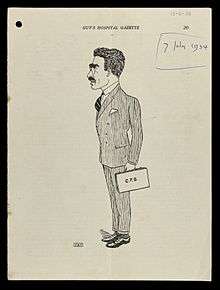Carlos Blacker
| Carlos Paton ('C.P') Blacker | |
|---|---|
 Cartoon of Carlos Paton Blacker | |
| Born |
8 December 1895 Paris, France |
| Died | 21 April 1975 |
| Fields | Family planning, Eugenics |
| Institutions | Guy's Hospital, Maudsley Hospital, |
| Education | Eton College |
| Alma mater | Balliol College Oxford |
| Notable awards | Galton Medal of the Eugenics Society |
| Spouse | Helen Maud Pilkington |
| Children | Ann Thetis Blacker |
Carlos Paton ('C.P.') Blacker GM MC FRCP (8 December 1895 – 21 April 1975)[1] was an eminent war hero, psychiatrist and eugenicist who worked with R.A. Fisher and Lionel Penrose.[2][3][4] Blacker was educated at Eton and Oxford where he attained distinction in biology under the tutelage of Julian Huxley. He served with the Coldstream Guards during World War I and was twice mentioned in dispatches and awarded the Military Cross, for action in which he was involved in on 15 September 1916. Twelve months previously he had lost his only sibling, a brother Robin, at Loos. Robin had also been an officer in the Coldstream Guards. C.P felt that war was dysgenic because it killed people who tended to be above the physical average and deterred thoughtful people from parenthood. He was deeply shaken by his war experience and in coming to terms with it and the loss of his brother and many of his contemporaries acknowledged a debt to Freud’s writings which stimulated in him an interest in psychiatry.
Qualifying in medicine in 1925, Blacker became a registrar in Guy's Hospital’s psychiatric department for three years and continued his study at the Maudsley Hospital. He later became a part-time member of its teaching staff and was later the first chairman of the newly-established Simon Population Trust.
In 1943, on active service, Blacker was awarded the George Medal. The official citation read:
A corporal had walked into a minefield and was killed. A Guards officer and a sergeant who had laid the mines at that point walked into the minefield to bring back the corporal’s body. Captain Blacker warned them of the risk, but the sergeant, confident that he knew the positions of the mines, went on with the officer. The sergeant was killed when he stepped on a mine and the officer was seriously wounded. With no knowledge of the mine pattern and no one to help, Captain Blacker went immediately to the rescue of the wounded officer. The officer was saved and recovered from his wounds.[5]
From 1931 to 1952, Blacker was secretary of the Eugenics Society and he gave it a new focus on birth control and population planning. . His appointment as Secretary was "not without some misgivings of [Leonard] Darwin, its chairman. The differences in outlook, aspirations and in judgement of these two men during their partnership in office in the Eugenics Society led to tensions which have been ably traced by Richard Soloway. Two prominent issues here were Darwin’s reluctance to endorse Blacker’s deep-rooted conviction that research and provision of contraception should be a major feature in the Eugenic Society’s strategy to reduce the fecundity of the lower, less able classes and his disagreement with Blacker’s aspiration to redirect more of the Eugenic Society’s effort from education and propaganda to research and promotion of contraception."
Ann Thetis Blacker (1927–2006), the painter and singer, was a daughter of Carlos Blacker.[6]
References
- ↑ ‘Blacker, Carlos Paton’, Who Was Who, A & C Black, 1920–2007; online edn, Oxford University Press, December 2007 accessed 22 December 2013.
- ↑ Watt, David C. "C P Blacker, R A Fisher and L Penrose on Eugenic Fundamentals". Archived from the original on December 24, 2013. Retrieved December 22, 2013.
- ↑ Dr C. P. Blacker (Obituaries), The Times Friday, April 25, 1975; pg. 18; Issue 59379; col G.
- ↑ Dr C. P. Blacker (Obituaries), E.M.N. The Times Saturday, April 26, 1975; pg. 14; Issue 59380; col F.
- ↑ "Notes and memoranda". Eugenics Review. 35 (2): 42–43. 1943. PMC 2986108
 .
. - ↑ Buckman, David (31 January 2007). "Thetis Blacker: Visionary batik painter". News – Obituaries. UK: The Independent.
External links
- Codebreakers: Makers of Modern Genetics: the Carlos Paton Blacker papers
- Nobody Better! The life of Robin Blacker 1897–1915